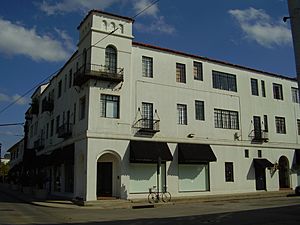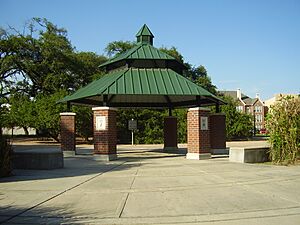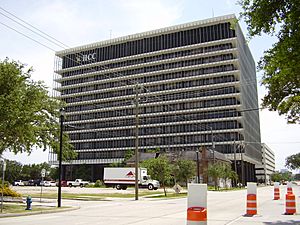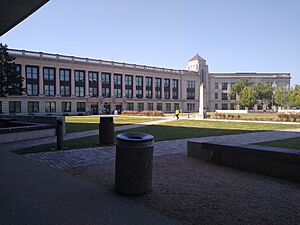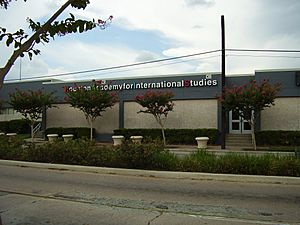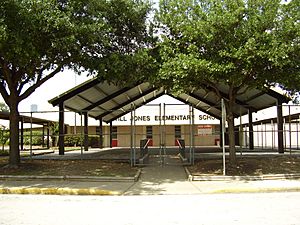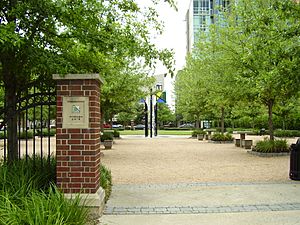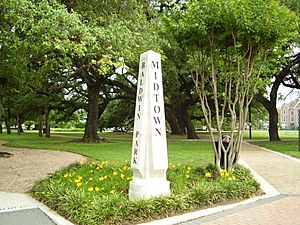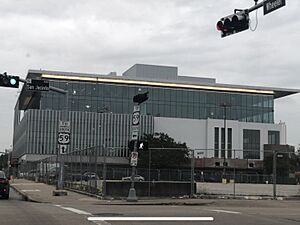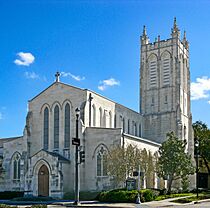Midtown, Houston facts for kids
Quick facts for kids
Midtown Houston
|
||
|---|---|---|
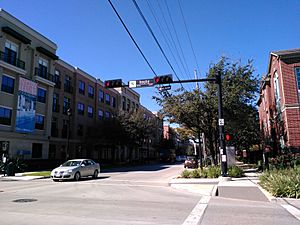
The intersection of Bagby and McGowen streets in western Midtown
|
||
|
||
| Country | ||
| State | ||
| County | Harris County | |
| City | ||
| Area | ||
| • Total | 1.24 sq mi (3.2 km2) | |
| Population
(2015)
|
||
| • Total | 8,597 | |
| • Density | 6,933/sq mi (2,677/km2) | |
| Time zone | UTC-6 (CST) | |
| • Summer (DST) | UTC-5 (CDT) | |
| ZIP codes |
77002, 77004, 77006
|
|
| Area code(s) | 713, 281, 346, and 832 | |
| Website | midtownhouston.com | |
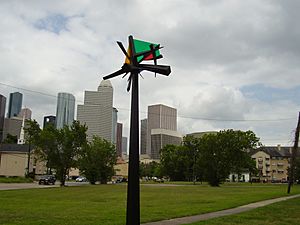
Midtown is a neighborhood in Houston, Texas. It's located southwest of Downtown Houston, which is the city center. An elevated highway, Interstate 45, separates Midtown from Downtown. Midtown has a street layout similar to Downtown, with streets forming a grid. Main Street and the METRORail Red Line are important parts of its design.
Midtown is surrounded by other areas: Neartown (Montrose) to the west, the Museum District to the south, and Interstate 69 to the east. Midtown covers about 1.24 square miles (3.2 km²) and had an estimated population of nearly 8,600 people in 2015.
In the 1800s, Midtown was a residential area with Victorian-style homes. However, in the late 1900s, many people and businesses left, and lots of land became empty. In the early 1990s, the Midtown Redevelopment Authority was formed. This group, along with new interest in Houston's city center, helped Midtown improve. Many young people moved in, and the area became lively, especially at night. Like other improved areas in Houston, Midtown has special street signs that match its logo. There are also many parks, sculptures, and businesses that use "Midtown" in their names to attract more visitors and residents. Midtown has continued to grow quickly in the 2010s.
Contents
- Midtown's Past: A Look at Its History
- What Midtown Looks Like: Cityscape
- Who Lives in Midtown: Demographics
- Getting Around: Transportation in Midtown
- Midtown's Businesses: Economy
- Learning in Midtown: Education
- Fun and Relaxation: Culture, Parks, and Recreation
- Places of Worship: Religion
- News and Information: Media
- Images for kids
- See also
Midtown's Past: A Look at Its History
Around 1906, the area that is now Midtown was part of the Third Ward and Fourth Ward. Before the 1950s, Midtown was a popular place to live. But as more businesses moved in, homeowners started leaving for quieter neighborhoods. The area then became a mix of small apartment buildings, low-rise businesses, and older houses. A city report said that the churches and the Houston Community College System Central campuses were the only things keeping the neighborhood stable.
How Little Saigon Began in Midtown
In the 1970s, Midtown became home to "Little Saigon." This was a neighborhood where many Vietnamese and Vietnamese Americans settled. They helped bring new life to Midtown Houston. By the 1980s, Travis and Milam Streets in Midtown reminded people of Saigon in the 1970s. Vietnamese businesses were mainly located around Milam, Webster, Fannin, and San Jacinto Streets. By 1991, Little Saigon had Vietnamese restaurants, hair salons, car repair shops, and travel agencies. Mimi Swartz from Texas Monthly wrote in 1991 that "Little Saigon is a place to begin easing into a new country."
Midtown's Growth and Changes
On June 24, 1994, a building called Isabella Court at 3909-3917 South Main Street was added to the National Register of Historic Places. This means it's an important historical site.
The City of Houston created the Midtown Tax Increment Reinvestment Zone (TIRZ) in 1995. This zone helped bring new, nicer townhomes and apartment buildings to western Midtown and the area near Elizabeth Baldwin Park. Between 1990 and 2000, the population in the Midtown area grew from 3,070 to 5,311 people. This was a 73% increase! About 2,200 new multi-family homes were built, especially along Louisiana Street and West Gray Street. This made the area more crowded. Also, more businesses opened, especially along Main Street and Louisiana Street. In 1999, the Texas Legislature created the Midtown Management District to help manage the area's development.
By 2004, rents became higher, and street construction made it harder for some Vietnamese American businesses to stay. Many of them moved to the bigger Houston Chinatown area. On May 1, 2004, during the 6th Annual Asian Pacific American Heritage Month Festival, the section of Midtown along Milam Street and Travis Street near Tuam Street was officially named "Little Saigon."
In 2009, the Houston City Council approved adding 8 more acres (3.2 hectares) to the Midtown TIRZ. This new area included the Asia House, the Buffalo Soldiers Museum, and the Museum of African-American Culture. In 2014, a website called Niche said that Midtown was the favorite neighborhood for young adults (millennials).
What Midtown Looks Like: Cityscape
In 2010, Denny Lee of The New York Times described Midtown as a "mixed-use" area, meaning it has both homes and businesses. He noted it was "dotted with" bánh mì restaurants. By 2012, many new bars, shops, and restaurants had opened in Midtown.
As of 2010, there were five flower shops along Fannin Street in Midtown. Ten years before that, there were more than a dozen. In 2003, most of these flower shop owners were Asian. The shops were located along four city blocks, centered on Rosedale Street. Their numbers decreased after the METRORail Red Line was built. Nancy Sarnoff of the Houston Chronicle reported in 2010 that the remaining flower shops believed the rail line caused some of their competitors to close.
Midtown does not have traditional hotels. As of 2023, it has one bed and breakfast and other rental units available for visitors.
Little Saigon: A Cultural Hub
Midtown was once known for having many Vietnamese businesses, which was called "Little Saigon." In the 1970s, Vietnamese people in Houston settled nearby. Midtown was close by and not too expensive. Even though few Vietnamese people lived in Midtown, it became a center for Vietnamese businesses and religious places throughout the Houston area.
By 1991, this Little Saigon had Vietnamese restaurants, hair salons, car shops, and travel agencies. By 2000, businesses included grocery stores, medical and legal offices, restaurants, music and video stores, hair styling shops, business service offices, and jewelry stores. Mimi Swartz of Texas Monthly said in 1991 that "Little Saigon is a place to begin easing into a new country." Thanks to a group of Vietnamese-American leaders, Vietnamese street signs were put up along Milam Street in Midtown. These signs have been there since 1998. In 2004, the city of Houston officially named this area "Little Saigon."
As Midtown became nicer and more expensive, property values and property taxes went up. This forced many Vietnamese-American businesses to move to other areas. By 2003, the number of Vietnamese businesses in Midtown decreased, with many moving to the Southwest Houston Little Saigon. Hope Roth stated around 2017 that new developments and higher costs for land and space caused Little Saigon to shrink. Roth noted that many of the area's restaurants still exist, but they now often serve more mainstream American tastes. In 2010, Denny Lee of The New York Times wrote that "traces" of the Vietnamese community still remained.
Who Lives in Midtown: Demographics
As of 2012, Midtown had about 8,600 people. The population in Midtown grew by 65% in just ten years.
According to the 2000 Census, the Midtown Super Neighborhood (which is mostly the same as the Midtown District) had 5,311 residents. Here's a breakdown of the population:
- 45% (2,439 people) were White.
- 18% (949 people) were Black or African American.
- 6% (320 people) were Asian.
- Less than 1% (8 people) were Native American.
- Less than 1% (35 people) were from other races.
- 1% (70 people) were from two or more races.
- 28% (1,490 people) were Hispanic or Latino.
There were 4,559 people over 18 years old. There were 3,219 males and 2,092 females. The area had 2,326 households, with an average of 1.78 people per household.
Getting Around: Transportation in Midtown

The Metropolitan Transit Authority of Harris County, Texas (METRO) manages public transportation in the area. The METRORail Red Line goes right through Midtown along Main Street. There are three stops in Midtown: Wheeler, Ensemble/HCC, and McGowen. Many bus routes also stop at Wheeler Station and the Downtown Transit Center, which is next to Midtown.
An intercity bus station for Greyhound Lines and other bus lines serving Mexico and Central America used to be in Midtown. This bus station was built in 1979. In 2008, the Houston Press called the Greyhound Terminal the "best place to people watch." In 2023, the Greyhound station was scheduled to close and move to a new location in Magnolia Park.
Midtown's Businesses: Economy
Spec's Wine, Spirits & Finer Foods has its main office in Midtown. At one time, the company FlightAware also had its headquarters in Midtown.
Learning in Midtown: Education
Colleges and Universities in Midtown
The Central Campus of the Houston Community College System is located in Midtown.
Midtown is also close to several other universities:
- University of Houston (UH)
- University of Houston–Downtown (UHD)
- Texas Southern University
- Rice University
- University of St. Thomas
Schools for Kids: Primary and Secondary Education
Public Schools Serving Midtown
Midtown is served by the Houston Independent School District (HISD).
- For elementary school, parts of Midtown are served by Gregory-Lincoln Education Center (in the Fourth Ward) and MacGregor Elementary School (near Hermann Park).
- For middle school, almost all students in Midtown go to Gregory-Lincoln Education Center. A small part of Midtown is zoned to Cullen Middle School. Starting in 2018, Baylor College of Medicine Academy at Ryan also became an option for students zoned to MacGregor elementary.
- For high school, most of Midtown is zoned to Lamar High School (in Upper Kirby). A small northwest part of Midtown is zoned to Reagan High School (in the Houston Heights).
HISD also has special magnet schools nearby:
- Houston Academy for International Studies, a magnet secondary school, is located at the HCCS Central campus.
- The Young Women's College Preparatory Academy, an alternative public school, is near Midtown.
- Carnegie Vanguard High School, a magnet school, is also close to Midtown.
A state charter school called Houston CAN! Academy Main is also located in Midtown.
History of Public Schools in Midtown
Charlotte Allen Elementary School opened on February 1, 1907. San Jacinto High School, located in Midtown, and Reagan High School opened in 1926. Lamar High School opened in 1937. In 1956, Allen Elementary moved, and its old location became J. Will Jones Elementary School. Ryan Middle School opened in 1958.
In 1971, San Jacinto High School stopped being a neighborhood school. In the same year, Fannin Elementary School, which was in Midtown, closed. In 1985, San Jacinto High School closed for good. As of 2008, the San Jacinto campus is now the central campus for Houston Community College.
J. Will Jones Elementary School, located in Midtown, had many students who were experiencing homelessness. Around 2009, over a third of its students were homeless, with about 30 coming from a Salvation Army shelter. The school provided bus services to several shelters.
Before the 2009–2010 school year, J. Will Jones Elementary was combined with Blackshear Elementary School. The former Jones campus became the home of Houston Academy for International Studies.
Private Schools in Midtown
As of 2019, the British International School of Houston offers a school bus service to Midtown.
The Kinkaid School, a private school, was located in Midtown from its start in 1906 until it moved to Montrose. In 1957, it moved to Piney Point Village. Saint Agnes Academy, another private school, was in Midtown from 1906 to 1963 before moving to the Sharpstown neighborhood.
Holy Rosary Catholic School opened around 1913 and closed in 1963. The school closed because many families moved away from the area due to new highways.
Fun and Relaxation: Culture, Parks, and Recreation
Midtown has several parks for people to enjoy.
- Midtown Park is located at the intersection of Bagby and Gray streets.
- Elizabeth Baldwin Park, run by the City of Houston, is at 1701 Elgin Street. This 4.88-acre (1.97 ha) park was acquired by the city in 1905. It has a stone fountain from 1912 and was improved in 1930 and 1931. Further improvements were made in the 2000s. The park was rededicated on November 13, 2006. It includes a Vietnamese Heritage Plaza that honors the Vietnamese community in Midtown.
- Peggy's Point Plaza Park, also run by the city, is at 4240 Main Street.
Rice University has its technology park, the Rice Innovation District, within Midtown.
In 2012, the Midtown Redevelopment Authority announced that a new park would be built in Midtown on a 3.5-acre (1.4 ha) empty lot.
The Ensemble Theatre, an African-American theater company, has its studio in Midtown. Founded in 1976, it is the largest African-American theater company in the United States.
The Farrago World Cuisine Restaurant opened in 2000, which was seen as a sign that Midtown was becoming more lively. This restaurant closed in July 2013.
Places of Worship: Religion
Trinity Episcopal Church is located in Midtown.
Holy Rosary Catholic Church, part of the Roman Catholic Archdiocese of Galveston-Houston, is also in Midtown. The church was started in 1913. In 2004, about 25% of its members were ethnic Vietnamese, and the church holds two masses each week in the Vietnamese language. This makes it one of five Vietnamese Catholic churches in the Houston area.
The former Temple Beth Israel is in Midtown.
News and Information: Media
The Houston Chronicle is the main city newspaper. The Midtown Paper is a local newspaper for the Midtown area.
Images for kids
-
Vietnamese language street signs in Midtown
See also
 In Spanish: Midtown Houston para niños
In Spanish: Midtown Houston para niños



